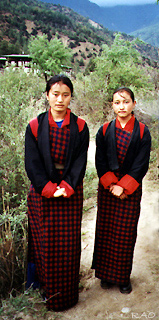 |
Bhutan's
Education |
|
 |
Bhutan Information |
|
|
 |
|
Girls out number the boys in many of the schools
in Thimphu |
 |
For
the majority of Bhutanese women, seeking an education was however, not
easy. Parents preferred girls to stay home, helping in domestic chores
and rearing a family when the time came. So the boys went to school while
the girls stayed home. When girls reached a certain age, there was the
parental pressure to get a job and start a family life. Those in schools
had to leave to help the family. "My parents coaxed me to get married when
I was in class eight," said Pema from Trashigang, a small time employee
in a private company.
Tshering,
a mother of two children and a government employee had to give up her schooling
because she had to look after her younger siblings. "I was good in studies
but I couldn't carry on because my parents needed me at home rather than
send me to school." Reasons are varied but a large population of Bhutanese
women did miss out on education in the early years of development. "Parents
also hesitated to send girls to schools which were far away from home because
of security reasons," said Dechen, a teacher. |

|
|
 |
"I
believe my mother tried everything to keep me away from being taken to
school," said 58 year old aum Pema Wangmo who is currently enrolled in
a non-formal education (NFE) centre. "Had she been a little wise, I would
not have to be attending this course at my age," she said.
An
education ministry official said that not sending girls to school had more
to do with "protecting the girl child rather than indulging in any form
of gender disparity." Schools were situated at long distances from homes
where the children had to walk for hours in some places. "Lack of accessibility
to schools was the main reason that prompted poor participation of the
parents in promoting education among their daughters. Girls were considered
more helpless and vulnerable and this discouraged parents from sending
their daughters to school," he added. The problem was largely in rural
Bhutan where most of the Bhutanese lived.
With
education for all as one of the priorities of the government, the gender
disparity in school enrolment has narrowed down in the past decade with
an overall increase in student enrolment. More than 0.1 million children
are enrolled in 412 schools and 14 institutions and vocational centers
around the country. At the primary level the gap between boys and girls
enrolment has significantly narrowed to less than 4 percent. Out of the
total of 93,974 currently in the primary level, girls constitute 47 percent
of the total students. Thimphu dzongkhag alone has 18 percent of girls
enrolled in school.
| Contributed
by by Kinley Y Dorji & Kinley Wangmo,KUENSEL, Bhutan's National Newspaper, 2006 |
 |
|





